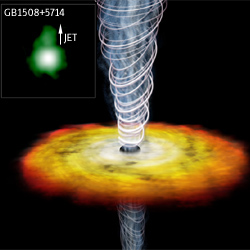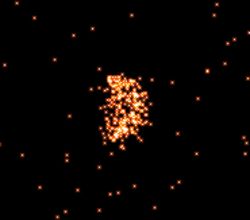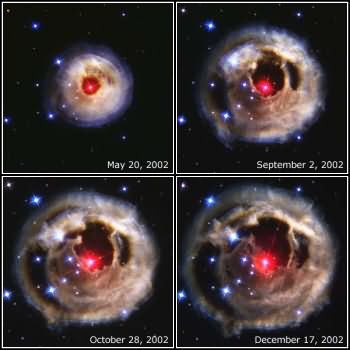2012 [ News Blog of Survive2012 ] |
|
RobertBast, December 25, 2003 at 10:22:00 AM AEDT
Gamma rays have a bit of kick Some old (but important) news that has resurfaced: "The formation of the Solar System was hurried along by a nearby gamma- ray burst, two astrophysicists in Ireland suspect. Rather than aborting the birth of planets, the flood of energy may have melted primordial dust grains, seeded the formation of meteorites and helped form the rocky planets, including Earth. ....calculate that a gamma-ray burst within 300 light years would have flooded the dusty disc circling the young Sun with enough energy to fuse up to 100 Earth masses of material into droplets that cooled into chondrules." So we find ourselves asking:
There are more than 1,000 stars within 300 light years of Earth, with over 200 being closer than 30 light years, and the closest being just 4 light years from us. The galactic centre, at a distance of about 25,000 light years is outside of the nominated range.
link me RobertBast, December 20, 2003 at 7:37:00 AM AEDT Beagle landing on Mars, Xmas Day I have always thought that you can't just rendevous with other planets on any day you choose, and that the motions of the solar system dictate it quite heavily. But I have no expertise in the matter. What concerns me is that, in this era of "too good to be true" stories (finding Saddam looking like that in a hole), the fact that the European Space Agency's Beagle 2 spacecraft will be landing on Mars on Xmas Day has me scratching my head for two reasons:
link me RobertBast, December 5, 2003 at 2:00:00 PM AEDT X-ray jet news  The above image is a NASA representation of "the most distant jet ever observed", spotted by NASA's Chandra X-ray Observatory. It extends more than 100,000 light years from a supermassive black hole.
The above image is a NASA representation of "the most distant jet ever observed", spotted by NASA's Chandra X-ray Observatory. It extends more than 100,000 light years from a supermassive black hole.
It's not just X-ray jets that explode out of black holes (like the one at the center of out galaxy), there are also gamma ray jets, X-ray jets, visible light jets and radio wave jets. Now scientists have decided they are all the same jet, with the same amount of energy released, but for some reason each has different amounts of energy coming out in different ways. So, sometimes x-rays, sometimes gamma-rays, sometimes radio waves....or a mixture. There is a good chance one of these jets of high energy particles will hit Earth one day (the year 2012?). Scientists don't think so, because for the pathetically short amount of time they have been watching the center of our galaxy, they haven't witnessed it.
link me RobertBast, October 17, 2003 at 9:56:00 AM AEST A Galaxy with no stars? "Astronomers have found the first "dark galaxy" - a black cloud of hydrogen gas and exotic particles, devoid of stars." This pretty much solves the problem of where all the dark matter is - hanging out in invisible clumps. It also brings up a worry, is there a dark galaxy nearby with a blackhole at its center? And could that black hole erupt?
link me RobertBast, May 15, 2003 at 5:59:00 PM AEST XRays from Venus  It is not well known, but Venus emits X-Rays. The above photograph is the first to show it, because it had to be taken from space (Chandra). Follow the link below for a brief explanation.
It is not well known, but Venus emits X-Rays. The above photograph is the first to show it, because it had to be taken from space (Chandra). Follow the link below for a brief explanation.
link me woelfin, May 3, 2003 at 6:35:00 AM AEST generation of stars for the esteemed readers and others who know German über sternenentstehung it is an interesting online-article about how stars generate link me RobertBast, May 2, 2003 at 8:56:00 PM AEST End is nigh? This website... ...is promoting the idea that Planet X is heading our way in the next few weeks. I have yet to see any believable evidence for a Planet X, let alone any indication of when it is coming. link me RobertBast, April 11, 2003 at 9:31:00 PM AEST Close-up of X-Ray Jet  This is the latest image of an X-Ray jet, this time from the closest radio-galaxy to us - Centaurus A which is only 10 million light years away
This is the latest image of an X-Ray jet, this time from the closest radio-galaxy to us - Centaurus A which is only 10 million light years away
link me RobertBast, March 27, 2003 at 11:12:00 PM AEDT A new type of Supernova 
Repeat after me: we've only observed a fraction of the weird events involving stars and galaxies - nothing can be ruled out. "The outburst of V838 Mon was somewhat similar to that of a nova, a more common stellar outburst. A typical nova is a normal star that dumps hydrogen onto a compact white-dwarf companion star. The hydrogen piles up until it spontaneously explodes by nuclear fusion — like a titanic hydrogen bomb. This exposes a searing stellar core, which has a temperature of hundreds of thousands of degrees Fahrenheit. By contrast, however, V838 Mon did not expel its outer layers. Instead, it grew enormously in size, with its surface temperature dropping to temperatures not much hotter than a light bulb. This behavior of ballooning to an immense size, but not losing its outer layers, is very unusual and completely unlike an ordinary nova explosion. "We are having a hard time understanding this outburst, which has shown a behavior that is not predicted by present theories of nova outbursts," says Bond. "It may represent a rare combination of stellar properties that we have not seen before."
link me RobertBast, March 4, 2003 at 10:48:00 PM AEDT Space Nasty 
"The Black Widow pulsar is emitting intense high-energy radiation that appears to be destroying a companion star through evaporation. It is one of a class of extremely rapid rotating neutron stars called millisecond pulsars." How scary is that? I feel uncomfortable being even as far away as 5,000 light years.
link me RobertBast, January 17, 2003 at 11:36:00 AM AEDT Scary galaxy Could Eta Carinae explode soon? Scientists have noticed that it is pumping out X-Rays every 5.52 years, which means it will do so again in the Nothern Hemisphere summer of 2003, then winter of 2008/2009, then summer 2014. Anyone looking at it can sense that it is soon to blow, and possibly directly affect us, or trigger something else.
"Giant jets of subatomic particles moving at nearly the speed of light have been found coming from thousands of galaxies across the Universe, but always from elliptical galaxies or galaxies in the process of merging — until now. " But now, for the first time, jets have been observed from a spiral galaxy. And guess what type of galaxy we live in???
link me RobertBast, January 9, 2003 at 7:38:00 AM AEDT Star to supernova soon "The star, called Rho Cassiopeia, is a hypergiant with 20 to 40 times the mass of the sun. " "Eventually, perhaps in a few thousand years, Dupree said Rho Cas will erupt into a supernova explosion, one of the most powerful releases of energy in the universe. That will rip the star apart in one final, gigantic spasm of violence." In a few thousand years, or perhaps tomorrow?
link me RobertBast, December 7, 2002 at 1:23:00 PM AEDT NASA radiation studies NASA is spending $44 million to simulate the effects of various types of space radiation - presumably because the only other examples of harm from radiation come from atomic bomb survivors. It's quite possible that they'll discover that low-energy, long-term radiation exposure can cause beneficial mutations. Also in the article, he best shielding against cosmic radiation is liquid hydrogen.
link me RobertBast, November 28, 2002 at 10:22:00 AM AEDT Galileo wakes up I'm very wary of these types of announcements from NASA. Spaceships that work fine until there is data they don't wish to share with the public. "The Galileo spacecraft, which went silent November 5 after making its closest approach to Jupiter, is now in good working order, except for its tape recorder, mission scientists said this week." The same thing happened on Eros, spacecraft miraculously starts working again...
link me RobertBast, October 26, 2002 at 10:34:00 AM AEST Milky Way black hole evidence "It comes from observations of a fast-moving star which orbits close to the hole, referred to by astronomers as Sagittarius A* (its location in the sky is in the southern constellation Sagittarius). Calculations based on the behaviour of the star suggest the black hole has a mass roughly 2.6 million times that of the Sun."
link me RobertBast, September 10, 2002 at 7:54:00 PM AEST Less cosmic rays, hotter Earth Researchers studying global warming have often been confounded by the differences between observed increases in surface-level temperatures and unchanging low-atmosphere temperatures. A study in the July 2002 issue of Journal of Geophysical Research-Space Physics, published by the American Geophysical Union, proposes for the first time that interstellar cosmic rays could be the missing link between the discordant temperatures observed during the last two decades ...indications of Earth's warming have coincided with decreased cosmic ray intensity during the 20th century.
link me RobertBast, August 29, 2002 at 4:16:00 PM AEST Jurassic Park for Mammoths Yep, although they don't have any actual mammoths yet, they are planning a park to put them in - in Siberia. "Those behind the planned park are already populating the site in north-east Siberia with other species from the Ice Age in hopeful anticipation of the mammoth's arrival. There are currently hundreds of wild horses and musk ox grazing the land by the River Kolyma, and talks to import bison from Canada are already underway."
link me RobertBast, July 26, 2002 at 6:48:00 PM AEST Cosmic Rays kill cameras But not this one...
link me RobertBast, July 11, 2002 at 10:29:00 AM AEST NASA bullshit?  Larger image
Larger image
The NEAR spacecraft came back to life, when there should have been no reason to do so, and now, when NASA have a wonderful chance to snap some close-ups of the Jovian moon Amalthea, they cite lack of funds. Maybe they just don't want to share what they think they are going to see?
link me RobertBast, July 1, 2002 at 10:17:00 PM AEST Massive solar eruption, July 1st, 2002  Bigger version of pic is here
Bigger version of pic is here
link me |
 Youre not logged in ... Login
 ... home
... search ... topics ... ... ... email me ... Home
... Tags
... Galleries
... antville home
   Survive 2012 2012 Myths and Facts End of the World on Dec 21 2012? 2012: Dire Gnosis Adult MatchMaker |
|||||||||||||||||||||||||||||||||||||||||||||||||||||||||||||||||||||||||||||||